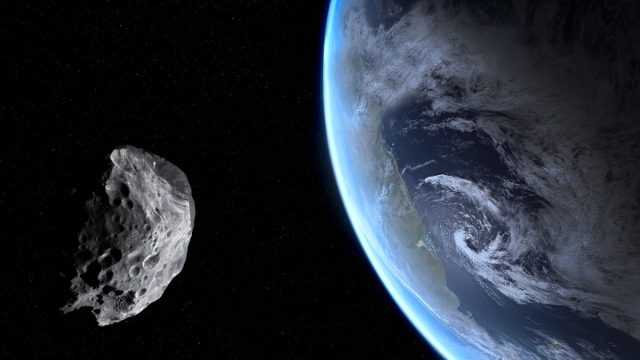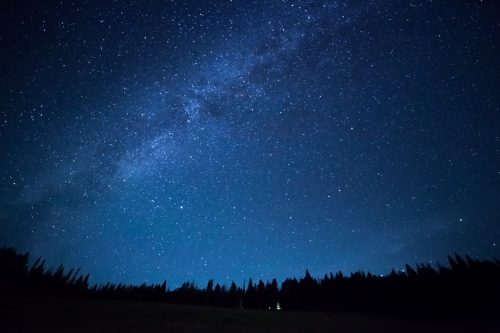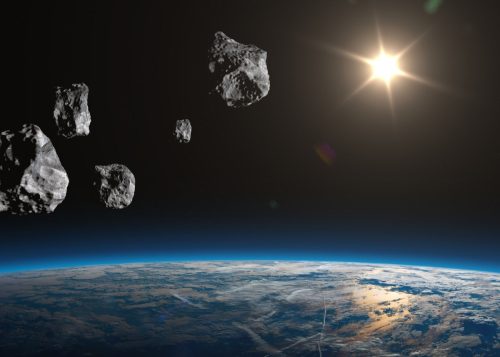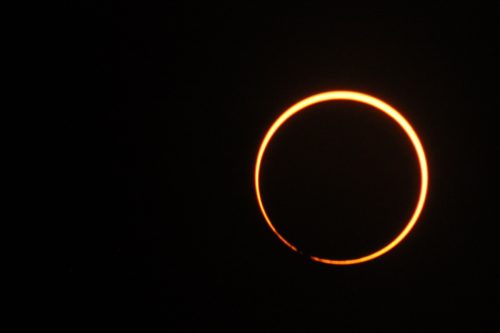Multiple Airplane-Sized Asteroids Passing Earth, Starting Tonight—How to See Them
None of the asteroids pose a threat to the planet, NASA confirms.

It's always exciting when a new cosmic event comes around, whether you manage to glimpse a shooting star or see a rare solar eclipse. But it's even more enthralling when multiple events happen in one week, which is exactly the case right now. According to NASA's Asteroid Watch dashboard, five asteroids will be passing Earth this week, three of which are the size of airplanes—and one that's even larger. Read on to find out how you can see them for yourself, starting tonight.
RELATED: A Special Solar Eclipse Will Create a "Ring of Fire" in the U.S.—Here's How to See It.
A house-sized asteroid is passing this evening.

According to NASA's dashboard, the first asteroid (2021 JA5) is approximately 59 feet in size, which is comparable to the size of a house. It's passing Earth this evening, getting within 3.17 million miles of our planet at its closest approach. For reference, the average distance between Earth and our moon is roughly 239,000 miles.
If you don't have a chance to catch 2021 JA5 tonight, rest assured you'll have plenty more options for asteroid viewing in the coming days.
RELATED: 8 Amazing Things You Can See in the Night Sky Without a Telescope.
Four more asteroids are anticipated to go by Earth this week.

On Friday, Sept. 8, two asteroids will fly by. One is airplane-sized at 83 feet (2023 QC5), while the other (2020 GE) is a bit smaller, at 26 feet, which is about the size of a standard bus. According to NASA, 2023 QC5 will get within 2.53 million miles of Earth at its closest, while 2020 GE will get within 3.56 million miles.
Another two asteroids are zooming past on Sunday, Sept. 10, both of which are airplane-sized. The first, 2023 QE8, is a whopping 170 feet in size—and it will get the closest to Earth of all, coming within 946,000 miles. The second Sunday asteroid, 2023 QF6, is 68 feet in size, getting within 1.65 million miles of us.
Asteroids that are larger than 150 meters and come within 4.6 million miles of the Earth are deemed "potentially hazardous objects." As the upcoming five asteroids meet the distance requirement, but not the size, they don't pose a threat.
"The five asteroids are not going to collide with the Earth. They are going to pass by," Paul Chodas, manager of the Center for Near Earth Object Studies (CNEOS) at NASA's Jet Propulsion Laboratory in California, told CBS8.
RELATED: NASA Says Solar Eruptions Are Increasing—Here's How That Could Affect Us.
Head to NASA's website to see these asteroids pass us in real-time.

Spotting an asteroid with the naked eye can be tough, and viewing some of the largest in our skies still requires a telescope. However, you can see asteroids and comets in real-time by visiting visit NASA's Eyes on Asteroids page, which uses data from CNEOS to compute "high-precision orbits."
Using the map, you can see exactly where the next five asteroids are in orbit—and check out the live countdown for when each object will get closest to Earth. Tonight, 2021 JA5 will pass by us at 5:31:38 p.m. Eastern Standard Time (EST), according to the map.
Another exciting event is coming up next month.

In a little over a month, you'll be able to catch another cosmic event, this one quite rare. It's a "ring of fire" solar eclipse, which occurs when the moon passes between the sun and the Earth at its farthest distance. According to NASA, because it's so far away, the moon appears smaller in the sky and doesn't completely cover the sun, creating a thin outer "ring of fire."
The annual event is slated this year for Saturday, Oct. 14, starting on the Northwest coast and moving south. According to NASA, the full "annular," or ring-shaped, eclipse will be visible from Oregon, Nevada, Utah, New Mexico, Texas, and some parts of California, Idaho, California, and Arizona. A partial solar eclipse will be visible in all 48 contiguous U.S. states, as well as Alaska.
NASA states that this is the last annular solar eclipse that will occur until June 21, 2039. At that time, Alaska will be the only U.S. state that can view it.
RELATED: For more up-to-date information, sign up for our daily newsletter.





















